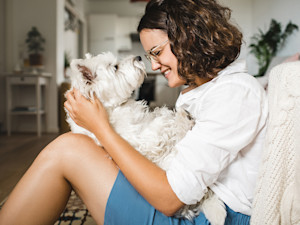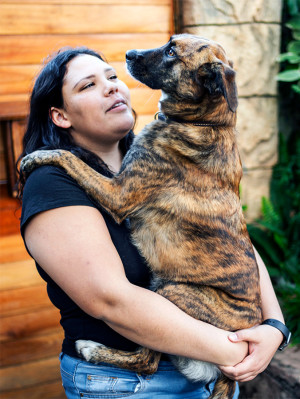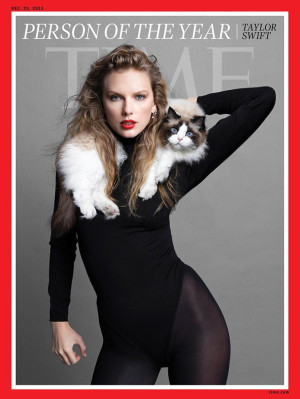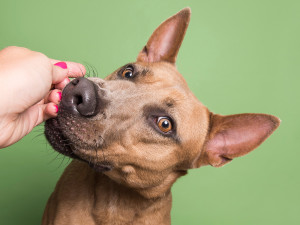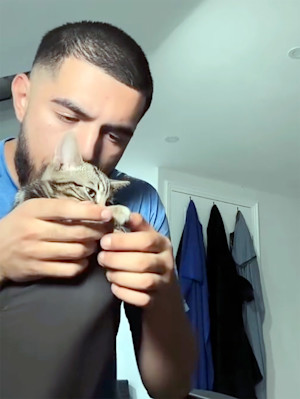Viral TikTok Trends Are Cute, But Does Your Pet Enjoy Them?
The real impact of social media trends on your pets’ well-being

Share Article
Ah, TikTok. The land of viral dances, life hacks and yes, endless pet videos. We all love seeing adorable cats and dogs doing hilarious things, but is the trend of sharing our pets online really as harmless as it seems? The reality, as a new study suggests, is that some of these viral moments could actually be harmful to our four-legged friends. We dive into the facts behind the feed, look at the potential psychological and physical impacts of viral trends on our pets, and explore how we can keep our pets safe while still enjoying their company on social media.
The rise of TikTok has brought with it a surge in pet content, capturing the hearts of millions worldwide. From dogs falling off sofas to cats dressed in costumes, these videos have become a staple of our social media diets. The charm of these clips is undeniable – they are funny, cute and endlessly shareable. However, as with many trends, there’s an underlying concern that often gets overlooked: the well-being of the animals involved.
To put it into perspective, data from Admiral Insuranceopens in new tab shows that over half of pet videos online (51 percent) show animals being scared or startled, and these clips have garnered an astonishing 1.4 billion views and 104 million likes. The popularity of such content raises important questions about the effects of these seemingly innocent pranks on our pets. According to these statistics by Admiral Insurance, a significant portion of pet videos on social media show animals in distressing situations, including:
51 percent showing them being scared or startled.
19 percent involving pets being dressed up.
41 percent depicting pets in potentially dangerous situations.
11 percent including signs of neglect.
It’s no secret that videos of cute dogs and cats can quickly go viral. Whether it's a dog performing a trick or a cat doing something unexpectedly funny, these clips garner millions of views and likes. However, the psychological and physical toll on pets can be profound, leading to long-term issues that far outweigh the fleeting joy of internet fame, and animal welfare organisations and experts are increasingly voicing their concerns. Are we really unwittingly causing them distress for the sake of a few laughs and some social media clout?
Scare tactics: the not-so-funny side
One of the most popular types of pet videos involves startling and scaring pets – think cucumbers strategically placed behind unsuspecting cats or sudden, loud noises introduced simply to see a dog’s reaction. While these clips might garner laughs and likes in the heat of the moment, the psychological toll on the animals is no joke.
Dominika Jagoda, a pet welfare expert at the RSPCAopens in new tab, warns, “Scaring or startling pets for likes and shares is totally unnecessary and can cause your pets distress. Whilst it might seem like harmless fun, it could be frightening and stressful for your pet and is likely to make them wary and even fearful around you in future.”
“Short-term fear could be expressed through trembling, hiding or cowering,” says Zoe Blake, a veterinary nurse and pet behaviour specialist, adding that “scaring a pet will nearly always cause a spike in heart rate and an increase in blood pressure.” The long-term consequences of such stress include chronic anxiety and even aggressive behaviours towards their parents or strangers.
Long-term anxiety can lead to avoidance behaviours and a loss of trust between pets and their pet parents. “Some pets may respond to being startled by using aggression as a defensive mechanism,” says Zoe. “Over time, the pet may react aggressively to anything it perceives as a threat.”
Zoe also points out that chronic stress can cause pets to avoid specific people or activities associated with the frightening experience; chronic stress can also lead to physical problems, as well as psychological. “Chronic stress can weaken a pet’s immune system, making them more susceptible to illness. Pets may become lethargic and withdrawn, and even lose their appetite if they become depressed,” says Zoe, which is far from the cute and funny reactions that viewers see in those fleeting moments on their screens.
Dressing up pets: cute or cruel?
The internet loves a good pet costume. From dogs in superhero capes to cats in festive jumpers, the videos are everywhere. But whilst it’s fun for us, what about for them? The Admiral Insurance findings show that 19 percent of distressed pet videos feature animals in costumes. With these clips racking up over 387 million views and 31 million likes, it’s clear that many viewers might not realise the discomfort that outfits can cause. Clothes that are too tight, too heavy or made from the wrong material can irritate a pet’s skin and cause significant stress.
“There can be clear benefits for dogs and cats wearing some forms of clothing in certain situations – such as to help keep dogs warm in cold weather,” notes Dominika. “However, clothing needs to allow pets to behave normally and should not restrict their ability to communicate or control their body temperature”. The key here is that clothing should be functional rather than purely decorative.
“Consider whether there is a functional purpose such as protection from cold, rain or snow,” adds Zoe. “If this isn’t the case and it is just for our entertainment, then consider strongly if the pet is actually benefiting. If you do feel they need some clothes, gradually introduce it and let them explore it by sniffing.”
Make sure your pet can still behave normally, Dominika advises. “Introduce your pet to the clothing gradually and for short periods initially, giving them treats at each stage so that it becomes something the pet feels good about. Always supervise your pet while they are in their clothing”. If a pet shows signs of distress, such as scratching at the outfit or trying to remove it, it’s crucial to remove the clothing immediately.
Tips for dressing pets safely
If you decide to dress your pet, here are some tips to ensure their comfort and safety:
Ensure the clothing fits well and is not too tight.
Use soft, breathable fabrics to avoid irritation.
Avoid small parts like buttons or sequins that could be swallowed.
Make sure the clothing does not obstruct their eyes, ears, nose or mouth.
Always supervise your pet while they are in their clothing.
If your pet shows signs of distress, remove the clothing immediately.
If your pet doesn’t tolerate clothing well, there are still ways to dress them up for photos without causing stress. Dominika suggests, “Owners might be able to add a decorative bandana or a fancy name tag to their pet’s usual collar, or decorate the lead rather than the animals themselves.”
Walking your cat may do more harm than good
One specific trend that has drawn criticism is ‘walking’ cats on leads. While it might seem like a good way to give indoor cats a taste of the outdoors, it can be highly stressful for them. “Cats are certainly different to dogs in their behaviour and response to restraint,” says Zoe. “Many are not accustomed to being restrained and may become stressed or anxious. This may make them want to hit the flight or fight button, and they will try to escape or display aggressive behaviour, which can lead to injury to the trachea, neck or spine.”
The RSPCA has also raised concerns about the trend lately, noting that cats have a strong sense of control and are likely to find being on a lead very stressful. Whilst some cats can be trained to walk on a lead, it requires patience and positive reinforcement and the process should be gradual to avoid any negative associations. Simply popping on a harness for a few likes and clicks isn’t the way to go about it. As always: Zoe stresses that you should pay attention to your cat’s behaviour and remove the harness if they show any signs of distress.
How to create pet content responsibly
As pet parents, we have an ethical responsibility to ensure the well-being of our furry companions. That doesn’t mean taking all the fun out of your relationship, or stopping posting about them altogether, but it does mean potentially rethinking how we involve them in our social media activities. The goal should be to capture their natural behaviour and joy, not to put them in uncomfortable or dangerous situations for the sake of entertainment. So, how can we still share the joy of our pets on social media without compromising their well-being?
The first step is to understand and respect your pet’s individual limits. If they seem stressed or uncomfortable with a particular situation or outfit, don’t force it. As Dominika advises, “Consider what your individual pet enjoys doing, whether this is scavenging for hidden treats around the house, taking part in agility, going on walks with dogs or playing with their toys”.
If you want to introduce your pet to something new, do it gradually. “Make sure to do this slowly and gradually, offering them plenty of praise and treats to ensure they see this as a positive activity,” says Dominika. This helps create a positive association with the new activity or item.
The best content often comes from capturing pets engaging in their natural behaviours. Showcasing them playing, exploring or learning new tricks can highlight their unique personalities without causing any distress. “Engaging them with the activities they like to do can easily be captured for social media to showcase their unique and individual personalities,” advises Dominika.
Here are some more tips for creating content with your pets without causing them distress:
Respect their boundaries: understand what your pet enjoys and avoid forcing them into uncomfortable situations.
Positive reinforcement: use treats and praise to encourage behaviours you want to capture.
Safe environment: ensure the setting is safe, with no potential hazards.
Natural behaviours: capture your pet doing what they naturally enjoy, whether it’s playing with a toy, exploring the garden or simply relaxing. If they’re not doing what you want, adapt your content, not their behaviour.
Short sessions: keep content creation sessions short to prevent stress and boredom.
Monitor their reactions: pay close attention to your pet’s body language and behaviour. If they seem stressed or anxious, stop immediately.
While TikTok and other social media platforms offer endless opportunities to share the joy pets bring to our lives, it’s crucial to prioritise their welfare. Understanding the potential psychological and physical impacts of these trends can help us make more informed choices. By respecting our pets’ limits, using positive reinforcement and focusing on their natural behaviours, we can create content that is not only entertaining but also safe and respectful.
So, next time you reach for your phone to capture a funny moment, take a moment to consider your pet’s perspective. After all, their well-being is far more important than any number of likes or views.

Orla Pentelow
Orla Pentelow is Kinship UK’s Senior Editor. She has previously written for British Vogue, Bustle, Yahoo and The Telegraph. When not at her desk liking dog videos she’s out and about with her rescue pup, Luna, who works primarily as chief distractor.
Related articles
![A dog lying on a rug with a litter of puppies feeding from her.]()
Why You Shouldn’t Adopt a Pet From Social Media or Buying/Selling Sites
It’s not quite the same as buying secondhand clothes…
![cat sitting outside 10 downing street]()
Cats With Jobs That No One Asked Them to Do
It’s a busy summer for Larry the Cat at Number 10. Here are some other moggies keeping the world running
![Tan dog eating a treat from the photographer's hand against a light green background]()
Sophie Gamand’s Secrets to Snapping Incredible Dog Pics
My pro tips for taking grid-worthy (and life-saving) portraits of your pooch
![Glen Powell and his dog Brisket wearing Stetson hats]()
Nepo Pups Are the Real Stars of the Summer, and They’re Living the High Life
Move over Brat Girl Summer, the nepo dogs are here to stay
![]()
Cutting Cat Nails Is Hard, Is This Unusual Viral Hack The Answer?
We asked a behaviourist if this content creator’s approach to cutting his kitten’s nails is something you can try at home

